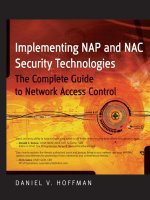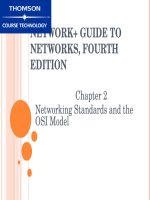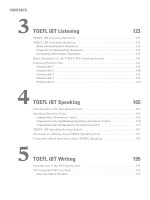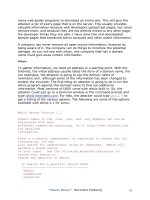Lecture Security + Guide to Network Security Fundamentals (2th edition) - Chapter 2: Attackers and their attacks
Bạn đang xem bản rút gọn của tài liệu. Xem và tải ngay bản đầy đủ của tài liệu tại đây (488.41 KB, 46 trang )
Chapter 2: Attackers and
Their Attacks
Security+ Guide to Network Security
Fundamentals
Second Edition
Objectives
• Develop attacker profiles
• Describe basic attacks
• Describe identity attacks
• Identify denial of service attacks
• Define malicious code (malware)
Developing Attacker Profiles
• Six categories:
– Hackers
– Crackers
– Script kiddies
– Spies
– Employees
– Cyberterrorists
Developing Attacker Profiles
(continued)
Hackers
• Person who uses advanced computer skills to attack
computers, but not with a malicious intent
• Use their skills to expose security flaws
Crackers
• Person who violates system security with malicious
intent
• Have advanced knowledge of computers and
networks and the skills to exploit them
• Destroy data, deny legitimate users of service, or
otherwise cause serious problems on computers and
networks
Script Kiddies
• Break into computers to create damage
• Are unskilled users
• Download automated hacking software from Web
sites and use it to break into computers
• Tend to be young computer users with almost
unlimited amounts of leisure time, which they can use
to attack systems
Spies
• Person hired to break into a computer and steal
information
• Do not randomly search for unsecured computers to
attack
• Hired to attack a specific computer that contains
sensitive information
Employees
• One of the largest information security threats to
business
• Employees break into their company’s computer for
these reasons:
– To show the company a weakness in their security
– To say, “I’m smarter than all of you”
– For money
Cyberterrorists
• Experts fear terrorists will attack the network and
computer infrastructure to cause panic
• Cyberterrorists’ motivation may be defined as
ideology, or attacking for the sake of their principles
or beliefs
• One of the targets highest on the list of
cyberterrorists is the Internet itself
Cyberterrorists (continued)
• Three goals of a cyberattack:
– Deface electronic information to spread disinformation
and propaganda
– Deny service to legitimate computer users
– Commit unauthorized intrusions into systems and
networks that result in critical infrastructure outages
and corruption of vital data
Understanding Basic Attacks
• Today, the global computing infrastructure is most
likely target of attacks
• Attackers are becoming more sophisticated, moving
away from searching for bugs in specific software
applications toward probing the underlying software
and hardware infrastructure itself
Social Engineering
• Easiest way to attack a computer system requires
almost no technical ability and is usually highly
successful
• Social engineering relies on tricking and deceiving
someone to access a system
• Social engineering is not limited to telephone calls or
dated credentials
Social Engineering (continued)
• Dumpster diving: digging through trash receptacles to
find computer manuals, printouts, or password lists
that have been thrown away
• Phishing: sending people electronic requests for
information that appear to come from a valid source
Social Engineering (continued)
• Develop strong instructions or company policies
regarding:
– When passwords are given out
– Who can enter the premises
– What to do when asked questions by another
employee that may reveal protected information
• Educate all employees about the policies and ensure
that these policies are followed
Password Guessing
• Password: secret combination of letters and numbers
that validates or authenticates a user
• Passwords are used with usernames to log on to a
system using a dialog box
• Attackers attempt to exploit weak passwords by
password guessing
Password Guessing (continued)
Password Guessing (continued)
• Characteristics of weak passwords:
– Using a short password (XYZ)
– Using a common word (blue)
– Using personal information (name of a pet)
– Using same password for all accounts
– Writing the password down and leaving it under the
mouse pad or keyboard
– Not changing passwords unless forced to do so
Password Guessing (continued)
• Brute force: attacker attempts to create every
possible password combination by changing one
character at a time, using each newly generated
password to access the system
• Dictionary attack: takes each word from a dictionary
and encodes it (hashing) in the same way the
computer encodes a user’s password
Password Guessing (continued)
• Software exploitation: takes advantage of any
weakness in software to bypass security requiring a
password
– Buffer overflow: occurs when a computer program
attempts to stuff more data into a temporary storage
area than it can hold
Password Guessing (continued)
• Policies to minimize password-guessing attacks:
– Passwords must have at least eight characters
– Passwords must contain a combination of letters,
numbers, and special characters
– Passwords should expire at least every 30 days
– Passwords cannot be reused for 12 months
– The same password should not be duplicated and
used on two or more systems
Weak Keys
• Cryptography:
– Science of transforming information so it is secure
while being transmitted or stored
– Does not attempt to hide existence of data;
“scrambles” data so it cannot be viewed by
unauthorized users
Weak Keys (continued)
• Encryption: changing the original text to a secret
message using cryptography
• Success of cryptography depends on the process
used to encrypt and decrypt messages
• Process is based on algorithms
Weak Keys (continued)
• Algorithm is given a key that it uses to encrypt the
message
• Any mathematical key that creates a detectable
pattern or structure (weak keys) provides an attacker
with valuable information to break the encryption
Mathematical Attacks
• Cryptanalysis: process of attempting to break an
encrypted message
• Mathematical attack: analyzes characters in an
encrypted text to discover the keys and decrypt
the data









